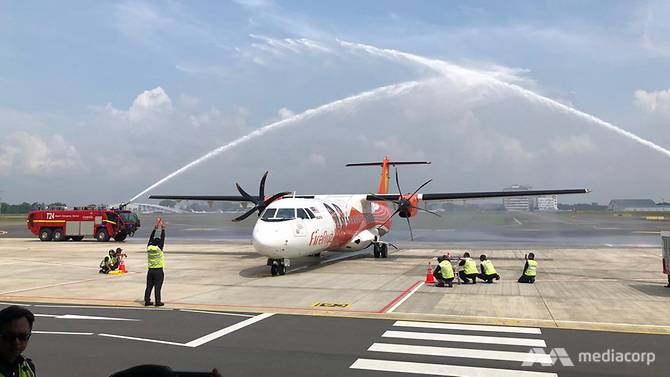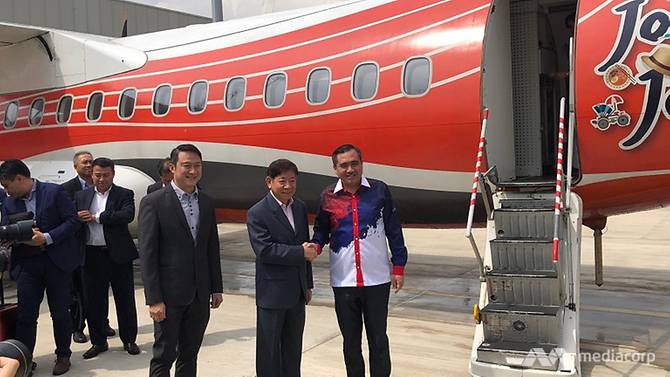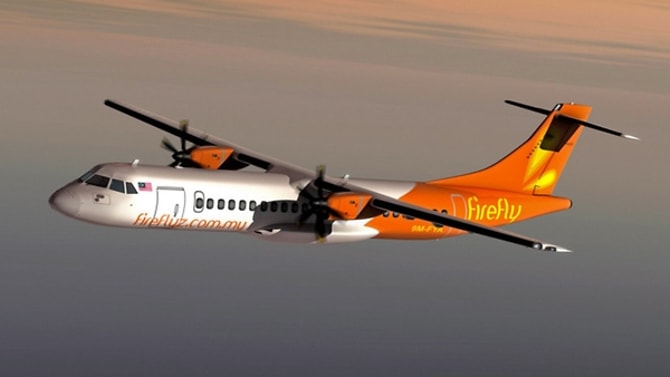www.gardensbythebay.com.sg
Monday 29 April 2019
Sunday 21 April 2019
Firefly resumes flights to Singapore as first plane lands at Seletar Airport
Malaysian carrier Firefly resumes flights to Singapore as first plane lands at Seletar Airport

Firefly flight FY3126 gets a ceremonial water cannon salute after it lands at Seletar Airport on Sunday April 21, 2019. (Photo: Lip Kwok Wai)
Malaysian budget carrier Firefly's first flight to Seletar Airport touched down at 10.53am on Sunday (Apr 21).
Flight FY3126 from Subang Airport landed as the airline resumed services to Singapore after five months due to an airspace dispute between Singapore and Malaysia.
Singapore Transport Minister Khaw Boon Wan welcomed his Malaysian counterpart Anthony Loke who was on board the flight.
There will be two Firefly flights a day between Subang and Seletar Airports from Apr 22 to 28, followed thereafter by six daily flights.

Singapore Transport Minister Khaw Boon Wan welcomes his Malaysian counterpart Anthony Loke who arrived at Seletar Airport on the Firefly flight. (Photo: Lip Kwok Wai)
The airline had suspended its flights to Singapore in December last year after failing to obtain approval from Malaysia’s aviation regulator to move its operations form Changi Airport to Seletar Airport.
Malaysia had opposed the Instrument Landing System (ILS) procedures in use at Seletar Airport, saying it restricted the construction of tall buildings at Johor's Pasir Gudang.
However, Singapore has said that the ILS simply puts on paper the existing flight paths, making safety rules clearer and more transparent. Singapore's Ministry of Transport (MOT) has also said that the procedures do not impose any additional impact on other airspace users as well as businesses and residents in Johor.
After months of negotiations, Malaysia suspended its permanent Restricted Area over Pasir Gudang indefinitely, while Singapore withdrew the ILS procedures at Seletar Airport, paving the way for Firefly to resume operations.
The ILS procedure refers to an assisted navigational aviation facility at the airport which provides vertical and horizontal guidance to pilots while the flight is descending and approaching the runway.
ILS would have allowed pilots to land in all weather conditions, even when visibility is low. It had been put in place at the request of Firefly.
Singapore and Malaysia will instead work together to develop GPS-based instrument approach procedures for Seletar Airport.
Before the suspension, Firefly offered 20 daily flights between Singapore and Subang, Ipoh and Kuantan.
Source: CNA/mn

Firefly flight FY3126 gets a ceremonial water cannon salute after it lands at Seletar Airport on Sunday April 21, 2019. (Photo: Lip Kwok Wai)
Malaysian budget carrier Firefly's first flight to Seletar Airport touched down at 10.53am on Sunday (Apr 21).
Flight FY3126 from Subang Airport landed as the airline resumed services to Singapore after five months due to an airspace dispute between Singapore and Malaysia.
Singapore Transport Minister Khaw Boon Wan welcomed his Malaysian counterpart Anthony Loke who was on board the flight.
There will be two Firefly flights a day between Subang and Seletar Airports from Apr 22 to 28, followed thereafter by six daily flights.

Singapore Transport Minister Khaw Boon Wan welcomes his Malaysian counterpart Anthony Loke who arrived at Seletar Airport on the Firefly flight. (Photo: Lip Kwok Wai)
The airline had suspended its flights to Singapore in December last year after failing to obtain approval from Malaysia’s aviation regulator to move its operations form Changi Airport to Seletar Airport.
Malaysia had opposed the Instrument Landing System (ILS) procedures in use at Seletar Airport, saying it restricted the construction of tall buildings at Johor's Pasir Gudang.
However, Singapore has said that the ILS simply puts on paper the existing flight paths, making safety rules clearer and more transparent. Singapore's Ministry of Transport (MOT) has also said that the procedures do not impose any additional impact on other airspace users as well as businesses and residents in Johor.
After months of negotiations, Malaysia suspended its permanent Restricted Area over Pasir Gudang indefinitely, while Singapore withdrew the ILS procedures at Seletar Airport, paving the way for Firefly to resume operations.
The ILS procedure refers to an assisted navigational aviation facility at the airport which provides vertical and horizontal guidance to pilots while the flight is descending and approaching the runway.
ILS would have allowed pilots to land in all weather conditions, even when visibility is low. It had been put in place at the request of Firefly.
Singapore and Malaysia will instead work together to develop GPS-based instrument approach procedures for Seletar Airport.
Before the suspension, Firefly offered 20 daily flights between Singapore and Subang, Ipoh and Kuantan.
Source: CNA/mn
Labels:
Air travel,
Airline,
Airport,
Malaysia,
News report,
Transportation
Thursday 18 April 2019
More wet and warm weather expected in last two weeks of April
More wet and warm weather expected in last two weeks of April
The weather here is set to continue to be wet and warm in the next two weeks, said the Meteorological Service Singapore (MSS) on Tuesday (April 16).
The prevailing inter-monsoon conditions in Singapore and the surrounding region are also expected to persist through May.
During the inter-monsoon period, low-level winds are generally light and variable in direction, said the MSS.
Strong solar heating of land areas also occur more frequently during this period.
Coupled with the convergence of winds over Singapore and the surrounding vicinity, the two factors lead to brief thundery showers with high lightning activity, usually in the afternoon.
In the second half of April, moderate to heavy short thundery showers are expected between the late morning and afternoon on six to eight days.
On one to two days, Sumatra squalls could bring widespread thundery showers and gusty winds in the morning.
The rainfall for April is expected to be near normal levels, said the MSS.
More rainy days are expected in the next two weeks as compared to the last two weeks of March.
The next two weeks are also expected to be warm, with the daily temperature on most days forecast to range between 25 deg C and 34 deg C, similar to what was experienced during the first two weeks of the month.
On a few afternoons, the daily maximum temperature could reach 35 deg C.
During the first half of April, light winds and strong solar heating of land areas led to thunderstorm clouds forming on most days. Intense, short thundery showers fell over many areas in the afternoon on some days.
Last Wednesday, thundery showers over the Tai Seng area in the late afternoon recorded 71.4mm of rain, the highest total rainfall in a day for the first two weeks of April.
On a few days in early April, the winds blew from the south-west or west, and Sumatra squalls moved over Singapore in the pre-dawn hours and early morning, bringing widespread thundery showers and gusty winds over many areas of the island.
A wind gust of 75.6kmh in Pasir Panjang during a passing squall on April 3 was the highest recorded wind gust for this month so far, said the MSS.
Despite the wet weather, there were several days with very warm weather in the first half of April. The highest daily maximum temperature recorded was 36 deg C in Admiralty on April 7.
On most days, the daily temperature ranged between 24 deg C and 34 deg C.
More than two-thirds of the island received below-normal rainfall in the first fortnight of April.
The Fortnightly Weather Outlook, a Web video series on the National Environment Agency's YouTube channel, is available for those interested to learn more about the weather conditions Singapore is experiencing.
~News courtesy of Straits Times~
The weather here is set to continue to be wet and warm in the next two weeks, said the Meteorological Service Singapore (MSS) on Tuesday (April 16).
The prevailing inter-monsoon conditions in Singapore and the surrounding region are also expected to persist through May.
During the inter-monsoon period, low-level winds are generally light and variable in direction, said the MSS.
Strong solar heating of land areas also occur more frequently during this period.
Coupled with the convergence of winds over Singapore and the surrounding vicinity, the two factors lead to brief thundery showers with high lightning activity, usually in the afternoon.
In the second half of April, moderate to heavy short thundery showers are expected between the late morning and afternoon on six to eight days.
On one to two days, Sumatra squalls could bring widespread thundery showers and gusty winds in the morning.
The rainfall for April is expected to be near normal levels, said the MSS.
More rainy days are expected in the next two weeks as compared to the last two weeks of March.
The next two weeks are also expected to be warm, with the daily temperature on most days forecast to range between 25 deg C and 34 deg C, similar to what was experienced during the first two weeks of the month.
On a few afternoons, the daily maximum temperature could reach 35 deg C.
During the first half of April, light winds and strong solar heating of land areas led to thunderstorm clouds forming on most days. Intense, short thundery showers fell over many areas in the afternoon on some days.
Last Wednesday, thundery showers over the Tai Seng area in the late afternoon recorded 71.4mm of rain, the highest total rainfall in a day for the first two weeks of April.
On a few days in early April, the winds blew from the south-west or west, and Sumatra squalls moved over Singapore in the pre-dawn hours and early morning, bringing widespread thundery showers and gusty winds over many areas of the island.
A wind gust of 75.6kmh in Pasir Panjang during a passing squall on April 3 was the highest recorded wind gust for this month so far, said the MSS.
Despite the wet weather, there were several days with very warm weather in the first half of April. The highest daily maximum temperature recorded was 36 deg C in Admiralty on April 7.
On most days, the daily temperature ranged between 24 deg C and 34 deg C.
More than two-thirds of the island received below-normal rainfall in the first fortnight of April.
The Fortnightly Weather Outlook, a Web video series on the National Environment Agency's YouTube channel, is available for those interested to learn more about the weather conditions Singapore is experiencing.
~News courtesy of Straits Times~
Foreigners leaving Singapore no longer need passports stamped
Foreigners leaving Singapore no longer need passports stamped from April 22
Foreigners leaving Singapore will no longer need to have their passports stamped from next Monday (April 22).
The Immigration and Checkpoints Authority (ICA) said on Wednesday that it would "cease the issuance of departure immigration endorsements", meaning stamps of departure dates on travel documents, from April 22.
This is part of ongoing efforts to streamline procedures at the checkpoints and make clearing departure immigration more efficient, it added.
Since September 2016, foreign travellers whose fingerprints were enrolled via the BioScreen system upon their arrival into Singapore have been able to use automated lanes when they leave the country.
Such travellers do not receive stamps on their passports.
Before that, all foreigners departing Singapore had to get their passports stamped with the date of their departure by immigration officers at the manned counters.
The ICA said it would also be informing foreign authorities on its move to cease departure immigration endorsement for foreigners.
More information can be found at www.ica.gov.sg
~News courtesy of Straits Times~
Foreigners leaving Singapore will no longer need to have their passports stamped from next Monday (April 22).
The Immigration and Checkpoints Authority (ICA) said on Wednesday that it would "cease the issuance of departure immigration endorsements", meaning stamps of departure dates on travel documents, from April 22.
This is part of ongoing efforts to streamline procedures at the checkpoints and make clearing departure immigration more efficient, it added.
Since September 2016, foreign travellers whose fingerprints were enrolled via the BioScreen system upon their arrival into Singapore have been able to use automated lanes when they leave the country.
Such travellers do not receive stamps on their passports.
Before that, all foreigners departing Singapore had to get their passports stamped with the date of their departure by immigration officers at the manned counters.
The ICA said it would also be informing foreign authorities on its move to cease departure immigration endorsement for foreigners.
More information can be found at www.ica.gov.sg
~News courtesy of Straits Times~
Wednesday 17 April 2019
Dr M: No need for high-speed rail in M'sia, yet
Dr M: No need for high-speed rail in M'sia, yet [NSTTV]
Malaysia does not yet need a high-speed train service, said Prime Minister Tun Dr Mahathir Mohamad today.
“At the moment, a high-speed train (service) is not really necessary for Malaysia, especially as it is only within Singapore and Kuala Lumpur.
“Later on, we might need a high-speed train from Johor Baru to Penang or even to the Thai border. So, we will not build the high-speed train yet,” he told reporters after launching local rail engineering innovation exhibition and technology showcase, or TECHNOMART.
Instead, Dr Mahathir said, the government was more keen on improving the existing railway services.
“We want to improve the quality of service given by our railway system, and that has been done to some extent, by double tracking and electrification.”
The prime minister, however, said Malaysia would go back to the discussion table with Singapore within two years to discuss the High-Speed Rail project.
“We have spoken to Singapore. For the time being, we are not going to build (the high-speed rail). We (have) asked for two years before we begin talks again.
“(For) the HSR at the moment, we are not giving out any contracts but we have had to compensate to Singapore earlier.”
Dr Mahathir was also asked whether Singapore would be agreeable to the idea of the HSR being connected to the Thai border.
“No, I don’t think they will consider. We only think about Kuala Lumpur.”
On the possibility of having an HSR alignment from Johor Baru to Penang, the prime minister said eventually, Malaysia would need such an alignment.
“When the time comes. We are not yet in need of such an alignment. Eventually, we will need it.”
On Sept 5, 2018, Singapore agreed to suspend the construction of the project until the end of May 2020.
As a result of Malaysia’s request for the deferment, it agreed to pay an abortive cost of S$15 million (RM45.6 million) to Singapore by Jan 31 of this year.
Dr Mahathir also said Malaysians had begun to appreciate using the railway system, which had improved over time.
He said some Malaysians would rather use the existing railway services than driving and facing traffic jams.
~News courtesy of New Straits Times~
Malaysia does not yet need a high-speed train service, said Prime Minister Tun Dr Mahathir Mohamad today.
“At the moment, a high-speed train (service) is not really necessary for Malaysia, especially as it is only within Singapore and Kuala Lumpur.
“Later on, we might need a high-speed train from Johor Baru to Penang or even to the Thai border. So, we will not build the high-speed train yet,” he told reporters after launching local rail engineering innovation exhibition and technology showcase, or TECHNOMART.
Instead, Dr Mahathir said, the government was more keen on improving the existing railway services.
“We want to improve the quality of service given by our railway system, and that has been done to some extent, by double tracking and electrification.”
The prime minister, however, said Malaysia would go back to the discussion table with Singapore within two years to discuss the High-Speed Rail project.
“We have spoken to Singapore. For the time being, we are not going to build (the high-speed rail). We (have) asked for two years before we begin talks again.
“(For) the HSR at the moment, we are not giving out any contracts but we have had to compensate to Singapore earlier.”
Dr Mahathir was also asked whether Singapore would be agreeable to the idea of the HSR being connected to the Thai border.
“No, I don’t think they will consider. We only think about Kuala Lumpur.”
On the possibility of having an HSR alignment from Johor Baru to Penang, the prime minister said eventually, Malaysia would need such an alignment.
“When the time comes. We are not yet in need of such an alignment. Eventually, we will need it.”
On Sept 5, 2018, Singapore agreed to suspend the construction of the project until the end of May 2020.
As a result of Malaysia’s request for the deferment, it agreed to pay an abortive cost of S$15 million (RM45.6 million) to Singapore by Jan 31 of this year.
Dr Mahathir also said Malaysians had begun to appreciate using the railway system, which had improved over time.
He said some Malaysians would rather use the existing railway services than driving and facing traffic jams.
~News courtesy of New Straits Times~
Labels:
Cross Border,
High Speed Railway,
Malaysia,
News report,
Transportation
Six months to a better idea on easing jams at Causeway
Six months to a better idea on easing jams at Causeway
The government will get a clearer picture within the next six months on ways to overcome congestion at the Causeway.
Foreign Affairs Minister Datuk Saifuddin Abdullah said both countries had discussed the overcrowding at the Causeway in which an estimated 265,000 commuters cross the link on a daily basis.
“We have discussed the problems and it is expected that in the next six months, we will get a clearer picture.
“At the moment, we are looking at short-term solutions such as adding more counters but this is still limited due to lack of space at the CIQ (Bangunan Sultan Iskandar Customs, Immigration and Quarantine),” he said after attending a seminar on global issues here yesterday.
Saifuddin also said that Malaysia was hopeful that Singapore would agree to move to the second phase of the 1962 Johor River Water Agreement negotiation, which involved price modality.
“For Malaysia, we are now entering the second phase of negotiation where we should be discussing price modality but to be fair to my colleagues from Singapore, I think they have not changed position,” he said.
If the talks or negotiation could not work, he said Malaysia and Singapore might have to resort to international arbitration, which would require the agreement of both sides.
Saifuddin said both attorneys-general from Malaysia and Singapore would discuss the matter.
It was reported that Malaysia and Singapore, which have differing views on the review of water rates, might resolve the longstanding dispute through arbitration.
~News courtesy of The Star~
The government will get a clearer picture within the next six months on ways to overcome congestion at the Causeway.
Foreign Affairs Minister Datuk Saifuddin Abdullah said both countries had discussed the overcrowding at the Causeway in which an estimated 265,000 commuters cross the link on a daily basis.
“We have discussed the problems and it is expected that in the next six months, we will get a clearer picture.
“At the moment, we are looking at short-term solutions such as adding more counters but this is still limited due to lack of space at the CIQ (Bangunan Sultan Iskandar Customs, Immigration and Quarantine),” he said after attending a seminar on global issues here yesterday.
Saifuddin also said that Malaysia was hopeful that Singapore would agree to move to the second phase of the 1962 Johor River Water Agreement negotiation, which involved price modality.
“For Malaysia, we are now entering the second phase of negotiation where we should be discussing price modality but to be fair to my colleagues from Singapore, I think they have not changed position,” he said.
If the talks or negotiation could not work, he said Malaysia and Singapore might have to resort to international arbitration, which would require the agreement of both sides.
Saifuddin said both attorneys-general from Malaysia and Singapore would discuss the matter.
It was reported that Malaysia and Singapore, which have differing views on the review of water rates, might resolve the longstanding dispute through arbitration.
~News courtesy of The Star~
Labels:
Cross Border,
Getting Around,
Getting in,
Malaysia,
News report,
Transportation
Monday 15 April 2019
Interactive Alice In Wonderland exhibit at ArtScience Museum
Down the rabbit hole: Interactive Alice In Wonderland exhibit at ArtScience Museum
Wonderland, which opens on Apr 13, follows the iconic character’s journey from books to films, video games and more.

Mad Hatter’s Tea Party at Wonderland. (Photo: Phoebe Powell)
Are you ready to fall down the rabbit hole and attend a Mad Hatter’s tea party? You can do so at the ArtScience Museum’s new Alice In Wonderland-themed exhibition, which opens on Saturday (Apr 13).
Based on author Lewis Carroll’s timeless stories, Wonderland is a show that follows Alice’s journey through popular culture using theatrical sets in interactive environments. Developed by the Australian Centre for the Moving Image (ACMI), Singapore is the first stop of its global tour.

Pool of Tears at Wonderland. (Photo: Anne Moffatt)
The exhibition will reveal how artists and filmmakers have portrayed Alice and her misadventures for over a century. Since her first appearance on the page in 1865, Alice has delighted audiences in more than 40 films and over 30 television programmes, and has gone on to inspire music videos, video games, high fashion, advertising and more.

The show Wonderland includes 18-screen panoramic displays of Alice through pop culture history. (Photo: Jovi Ho)
The exhibition includes over 300 artefacts and objects, including first-edition books, drawings, original costumes, films, animation, puppetry, and original work by theatrical designer Anna Tregloan and digital creative studios Sandpit, Grumpy Sailor and Mosster Studio.
Expect light shows that bring the Mad Hatter's tea party to life, 18-screen panoramic displays that feature the history of Alice in pop culture and a chance to transform yourself into one of the Queen's card soldiers onscreen.

Lost Map of Wonderland at Carroll’s drawing room. (Photo: Phoebe Powell)
Wonderland takes its inspiration from two of Lewis Carroll’s most iconic stories: Alice’s Adventures In Wonderland (1865) and Through The Looking Glass, and What Alice Found There (1871).
The exhibition charts the cultural, technological and social shifts that have compelled filmmakers to create their own visual interpretation of Alice and her adventures over the past century.

At the Wonderland exhibit at ArtScience Museum. (Photo: Jovi Ho)
From the first screen adaptation by Cecil M Hepworth in 1903 to the contemporary blockbusters of the 2000s, Wonderland also showcases the developments in special effects from pre-cinematic entertainment to silent film, animation to puppetry, live-action cinema, CGI, 3D and beyond.
Films such as Lou Bunin’s Alice Au Pays des Merveilles (1949), Jan Svankmajer’s acclaimed Alice (1988), the Quay Brothers’ experimental Alice In Not So Wonderland (2007), and television versions by broadcasters BBC and NBC will be featured in the exhibition.

(Photo: Phoebe Powell)
Speaking at the launch of the exhibition, Paul Bowers, ACMI's director of exhibitions and collections, teased that the exhibition will be headed to London following the end its run here in September. Museums in California and Japan have also expressed interest in hosting the exhibition, he added.
Wonderland runs from Apr 13 to Sep 22 at the ArtScience Museum. For more details, visit https://www.marinabaysands.com/museum.html.
~Channel News Asia~
Wonderland, which opens on Apr 13, follows the iconic character’s journey from books to films, video games and more.

Mad Hatter’s Tea Party at Wonderland. (Photo: Phoebe Powell)
Are you ready to fall down the rabbit hole and attend a Mad Hatter’s tea party? You can do so at the ArtScience Museum’s new Alice In Wonderland-themed exhibition, which opens on Saturday (Apr 13).
Based on author Lewis Carroll’s timeless stories, Wonderland is a show that follows Alice’s journey through popular culture using theatrical sets in interactive environments. Developed by the Australian Centre for the Moving Image (ACMI), Singapore is the first stop of its global tour.

Pool of Tears at Wonderland. (Photo: Anne Moffatt)
The exhibition will reveal how artists and filmmakers have portrayed Alice and her misadventures for over a century. Since her first appearance on the page in 1865, Alice has delighted audiences in more than 40 films and over 30 television programmes, and has gone on to inspire music videos, video games, high fashion, advertising and more.

The show Wonderland includes 18-screen panoramic displays of Alice through pop culture history. (Photo: Jovi Ho)
The exhibition includes over 300 artefacts and objects, including first-edition books, drawings, original costumes, films, animation, puppetry, and original work by theatrical designer Anna Tregloan and digital creative studios Sandpit, Grumpy Sailor and Mosster Studio.
Expect light shows that bring the Mad Hatter's tea party to life, 18-screen panoramic displays that feature the history of Alice in pop culture and a chance to transform yourself into one of the Queen's card soldiers onscreen.

Lost Map of Wonderland at Carroll’s drawing room. (Photo: Phoebe Powell)
Wonderland takes its inspiration from two of Lewis Carroll’s most iconic stories: Alice’s Adventures In Wonderland (1865) and Through The Looking Glass, and What Alice Found There (1871).
The exhibition charts the cultural, technological and social shifts that have compelled filmmakers to create their own visual interpretation of Alice and her adventures over the past century.

At the Wonderland exhibit at ArtScience Museum. (Photo: Jovi Ho)
From the first screen adaptation by Cecil M Hepworth in 1903 to the contemporary blockbusters of the 2000s, Wonderland also showcases the developments in special effects from pre-cinematic entertainment to silent film, animation to puppetry, live-action cinema, CGI, 3D and beyond.
Films such as Lou Bunin’s Alice Au Pays des Merveilles (1949), Jan Svankmajer’s acclaimed Alice (1988), the Quay Brothers’ experimental Alice In Not So Wonderland (2007), and television versions by broadcasters BBC and NBC will be featured in the exhibition.

(Photo: Phoebe Powell)
Speaking at the launch of the exhibition, Paul Bowers, ACMI's director of exhibitions and collections, teased that the exhibition will be headed to London following the end its run here in September. Museums in California and Japan have also expressed interest in hosting the exhibition, he added.
Wonderland runs from Apr 13 to Sep 22 at the ArtScience Museum. For more details, visit https://www.marinabaysands.com/museum.html.
~Channel News Asia~
Delays expected at Checkpoints over Good Friday weekend: ICA
Delays expected at Woodlands and Tuas Checkpoints over Good Friday weekend: ICA
Travellers using the Woodlands and Tuas Checkpoints during the Good Friday weekend can expect delays and heavy traffic, the Immigration & Checkpoints Authority (ICA) said on Friday (Apr 12).
Traffic flow through both land checkpoints is expected to be particularly heavy between Apr 18 and Apr 19.
“Travellers using the land checkpoints during these periods can expect delays and are advised to adjust their travel plans where necessary,” ICA said.
"Security at our checkpoints remains the ICA's top priority against any potential threats to Singapore," it said. “With security checks, traffic build-up is inevitable, especially when large numbers of travellers use the checkpoints at the same time."
Travellers were also reminded not to carry prohibited items such as firecrackers, pop pops and chewing gum.
Travellers who carry dutiable or controlled items such as eggs, meat products and potted plants should also declare these to ICA officers prior to checks.

AVOID QUEUE-CUTTING
ICA also said there have been "many instances of queue-cutting" at both checkpoints during peak periods, which can cause congestion and compromise safety.
It also reminded motorists to observe traffic rules, maintain land discipline and cooperate with checkpoint officers.
Before embarking on their journeys, motorists are advised to check the traffic situation at the Woodlands and Tuas Checkpoints through the One Motoring website or via the Expressway Monitoring & Advisory System installed along the BKE and AYE respectively.
Motorists can also check ICA’s Facebook page for updates on the traffic situation at both checkpoints.
Source: CNA/zl(cy)
Travellers using the Woodlands and Tuas Checkpoints during the Good Friday weekend can expect delays and heavy traffic, the Immigration & Checkpoints Authority (ICA) said on Friday (Apr 12).
Traffic flow through both land checkpoints is expected to be particularly heavy between Apr 18 and Apr 19.
“Travellers using the land checkpoints during these periods can expect delays and are advised to adjust their travel plans where necessary,” ICA said.
"Security at our checkpoints remains the ICA's top priority against any potential threats to Singapore," it said. “With security checks, traffic build-up is inevitable, especially when large numbers of travellers use the checkpoints at the same time."
Travellers were also reminded not to carry prohibited items such as firecrackers, pop pops and chewing gum.
Travellers who carry dutiable or controlled items such as eggs, meat products and potted plants should also declare these to ICA officers prior to checks.

AVOID QUEUE-CUTTING
ICA also said there have been "many instances of queue-cutting" at both checkpoints during peak periods, which can cause congestion and compromise safety.
It also reminded motorists to observe traffic rules, maintain land discipline and cooperate with checkpoint officers.
Before embarking on their journeys, motorists are advised to check the traffic situation at the Woodlands and Tuas Checkpoints through the One Motoring website or via the Expressway Monitoring & Advisory System installed along the BKE and AYE respectively.
Motorists can also check ICA’s Facebook page for updates on the traffic situation at both checkpoints.
Source: CNA/zl(cy)
Labels:
Cross Border,
Getting Around,
Getting in,
Malaysia,
News report,
Transportation
Malaysian carrier Firefly to resume Singapore flights with twice-daily trips
Malaysian carrier Firefly to resume Singapore flights with twice-daily trips

Malaysian budget carrier Firefly said on Friday (Apr 12) that it will resume flights to Singapore with two trips a day.
The move comes after Malaysia suspended its permanent Restricted Area over Pasir Gudang indefinitely, while Singapore withdrew the Instrument Landing System procedures at Seletar Airport, paving the way for Firefly to resume operations.
Firefly will offer two flights a day between Subang and Seletar Airports from April 22 to 28, followed thereafter by six daily flights, it said.
"The schedule takes into account stringent safety measures that are in compliance with the technical requirements established by the Civil Aviation Authority of Malaysia," it said.
Chief executive officer Philip See said the flights will play a significant role in strengthening economic and social ties between Singapore and Malaysia.

"It's important for business, for connecting family and friends, and for tourism, to have our Singapore flights reinstated," he said.
"The new schedule, along with other service enhancements, will be progressively rolled out over the coming months."
Going forward, the 12-year-old airline aims to resume a full schedule once the necessary technical and regulatory approvals are secured.
Tickets are available for purchase from Friday via website www.fireflyz.com.my, the mobile app or the call centre at 03-7845 4543.
Firefly suspended its flights to Singapore in December last year, after it was unable to obtain approval from Malaysia’s aviation regulator to move its operations from Changi Airport to Seletar Airport.
Before the suspension, Firefly offered 20 daily flights between Singapore and Subang, Ipoh and Kuantan.
Source: Bernama/CNA/aj(mi)

Malaysian budget carrier Firefly said on Friday (Apr 12) that it will resume flights to Singapore with two trips a day.
The move comes after Malaysia suspended its permanent Restricted Area over Pasir Gudang indefinitely, while Singapore withdrew the Instrument Landing System procedures at Seletar Airport, paving the way for Firefly to resume operations.
Firefly will offer two flights a day between Subang and Seletar Airports from April 22 to 28, followed thereafter by six daily flights, it said.
"The schedule takes into account stringent safety measures that are in compliance with the technical requirements established by the Civil Aviation Authority of Malaysia," it said.
Chief executive officer Philip See said the flights will play a significant role in strengthening economic and social ties between Singapore and Malaysia.

"It's important for business, for connecting family and friends, and for tourism, to have our Singapore flights reinstated," he said.
"The new schedule, along with other service enhancements, will be progressively rolled out over the coming months."
Going forward, the 12-year-old airline aims to resume a full schedule once the necessary technical and regulatory approvals are secured.
Tickets are available for purchase from Friday via website www.fireflyz.com.my, the mobile app or the call centre at 03-7845 4543.
Firefly suspended its flights to Singapore in December last year, after it was unable to obtain approval from Malaysia’s aviation regulator to move its operations from Changi Airport to Seletar Airport.
Before the suspension, Firefly offered 20 daily flights between Singapore and Subang, Ipoh and Kuantan.
Source: Bernama/CNA/aj(mi)
Labels:
Air travel,
Airline,
Airport,
Malaysia,
News report,
Transportation
Sunday 14 April 2019
Jewel Changi Airport set to be icon for Singapore
Jewel Changi Airport set to be icon for Singapore, says architect Moshe Safdie

Jewel Changi Airport architect Moshe Safdie drew inspiration from the science fiction film Avatar (2009), which had a landscape that he says blew his mind.
Multi-award-winning architect Moshe Safdie says that he expects Jewel Changi Airport to become a powerful icon for Singapore.
Mr Safdie, 80, who had also designed Marina Bay Sands (MBS), said he did not expect that MBS would become a landmark symbol of Singapore, possibly exceeding the status of the Sydney Opera House.
"I do predict now, though, that Jewel will become an icon for Singapore no less than MBS," he told reporters on Friday (April 12), ahead of Jewel Changi Airport's official opening on Wednesday.
While many architects focus on the outward structure and form of a building, much of Jewel's beauty lies within the 135,700 sq m development. The centrepiece of Jewel is a five-storey garden with a 40m-tall indoor waterfall and more than 2,000 trees and palms.
"That is the difference between the 10 minute 'wow' and the long lived 'wow'," said the Canadian-Israeli designer.
When he first discussed with property developer CapitaLand for a thematic attraction to go with the retail space for Jewel, he said "the obvious ideas started flying around".
"Dinosaurs, an aquarium, some thematic kind of attraction. But we, as the architects in the room, resisted this notion of something limited."
Jewel Changi Airport ready for its coming-out party and plans to wow 500,000 visitors over next six days Mr Safdie, founder of Safdie Architects, says that such attractions have a limited lifespan and would appeal only to a particular age range.
"Why would passengers want to come back again after seeing it once?"
Instead, he aimed for an attraction that would appeal to every age and income group.
"That led me to think of some kind of great paradise and a mystical garden. Something that would be appropriate for an airport and that is a place of serenity and repose."
He drew inspiration from the science fiction film Avatar (2009), which had a landscape that he says blew his mind.
"At some point we tried to get a hanging rock for the garden. To be placed in the middle of the dome. But it was too heavy."
The shape of the building, he says, is like a doughnut, or in geometrical terms, a torus.
The unique shape means that rain that falls on the dome naturally collects towards the centre, thus forming the building's indoor waterfall.
The HSBC Rain Vortex, the world's tallest indoor waterfall, features water falling through the roof at a velocity of 10,000 gallons per minute.
Jewel Changi Airport opens
The water is then circulated through pipes concealed within the building. A water tank with a 500,000-litre capacity is stored at basement three of Jewel. Rainwater is also harvested for the landscape irrigation system.
While Mr Safdie had quite a free hand, he faced some challenges while designing Jewel.
One consideration was the existing Skytrain tracks that will run through Jewel.
"When we designed the torus, we wanted it to be symmetrical with the oculus in the middle. That would have meant that since the train runs in the centre line of the building - that every train coming through would get a train wash. I think that would have caused issues."
So the oculus of the torus had to be moved off-centre, which was a "geometric nightmare". But he said the asymmetry makes the building more beautiful and "created a tension in the geometry".
Another challenge was height restrictions - the development had to be below the radar of Changi Airport's iconic control tower.
"That limited us to about 37m above street level. We could have used more height to get more curvature to the dome as it would have been more efficient."
But the biggest challenge, said Mr Safdie, was making sure that the building was comfortable for both people and plants.
"We needed to get enough sunlight in for the plants but still keep the temperature at a comfortable 24 degrees for the people."
Besides air-conditioning, there are also chilled pipes in the floors and fogging devices near the top of the waterfall to cool the air. In an open space in Canopy Park, retractable shades have been mounted on the roof to help provide shade.
Asked what he thinks of comments that Jewel looks like MBS, Mr Safdie is unperturbed.
"If Jewel looks like Marina Bay Sands, then I look like a horse. I can't see it. Yes, it has similar ingredients, it has shopping and gardens. But in essence they are totally different."
~News courtesy of Straits Times~

Jewel Changi Airport architect Moshe Safdie drew inspiration from the science fiction film Avatar (2009), which had a landscape that he says blew his mind.
Multi-award-winning architect Moshe Safdie says that he expects Jewel Changi Airport to become a powerful icon for Singapore.
Mr Safdie, 80, who had also designed Marina Bay Sands (MBS), said he did not expect that MBS would become a landmark symbol of Singapore, possibly exceeding the status of the Sydney Opera House.
"I do predict now, though, that Jewel will become an icon for Singapore no less than MBS," he told reporters on Friday (April 12), ahead of Jewel Changi Airport's official opening on Wednesday.
While many architects focus on the outward structure and form of a building, much of Jewel's beauty lies within the 135,700 sq m development. The centrepiece of Jewel is a five-storey garden with a 40m-tall indoor waterfall and more than 2,000 trees and palms.
"That is the difference between the 10 minute 'wow' and the long lived 'wow'," said the Canadian-Israeli designer.
When he first discussed with property developer CapitaLand for a thematic attraction to go with the retail space for Jewel, he said "the obvious ideas started flying around".
"Dinosaurs, an aquarium, some thematic kind of attraction. But we, as the architects in the room, resisted this notion of something limited."
Jewel Changi Airport ready for its coming-out party and plans to wow 500,000 visitors over next six days Mr Safdie, founder of Safdie Architects, says that such attractions have a limited lifespan and would appeal only to a particular age range.
"Why would passengers want to come back again after seeing it once?"
Instead, he aimed for an attraction that would appeal to every age and income group.
"That led me to think of some kind of great paradise and a mystical garden. Something that would be appropriate for an airport and that is a place of serenity and repose."
He drew inspiration from the science fiction film Avatar (2009), which had a landscape that he says blew his mind.
"At some point we tried to get a hanging rock for the garden. To be placed in the middle of the dome. But it was too heavy."
The shape of the building, he says, is like a doughnut, or in geometrical terms, a torus.
The unique shape means that rain that falls on the dome naturally collects towards the centre, thus forming the building's indoor waterfall.
The HSBC Rain Vortex, the world's tallest indoor waterfall, features water falling through the roof at a velocity of 10,000 gallons per minute.
Jewel Changi Airport opens
The water is then circulated through pipes concealed within the building. A water tank with a 500,000-litre capacity is stored at basement three of Jewel. Rainwater is also harvested for the landscape irrigation system.
While Mr Safdie had quite a free hand, he faced some challenges while designing Jewel.
One consideration was the existing Skytrain tracks that will run through Jewel.
"When we designed the torus, we wanted it to be symmetrical with the oculus in the middle. That would have meant that since the train runs in the centre line of the building - that every train coming through would get a train wash. I think that would have caused issues."
So the oculus of the torus had to be moved off-centre, which was a "geometric nightmare". But he said the asymmetry makes the building more beautiful and "created a tension in the geometry".
Another challenge was height restrictions - the development had to be below the radar of Changi Airport's iconic control tower.
"That limited us to about 37m above street level. We could have used more height to get more curvature to the dome as it would have been more efficient."
But the biggest challenge, said Mr Safdie, was making sure that the building was comfortable for both people and plants.
"We needed to get enough sunlight in for the plants but still keep the temperature at a comfortable 24 degrees for the people."
Besides air-conditioning, there are also chilled pipes in the floors and fogging devices near the top of the waterfall to cool the air. In an open space in Canopy Park, retractable shades have been mounted on the roof to help provide shade.
Asked what he thinks of comments that Jewel looks like MBS, Mr Safdie is unperturbed.
"If Jewel looks like Marina Bay Sands, then I look like a horse. I can't see it. Yes, it has similar ingredients, it has shopping and gardens. But in essence they are totally different."
~News courtesy of Straits Times~
Wednesday 10 April 2019
M'sia-S'pore committed to resolve causeway congestion
M'sia-S'pore committed to resolve causeway congestion
Malaysia and Singapore are still committed to resolve congestion issues at their overland border crossings at the Causeway and Second Link.
Prime Minister Tun Dr Mahathir Mohamad said the issue, which affects hundreds of thousands of commuters who ply the routes daily, was a problem that needed attention.
"Traffic congestion at the Causeway and Second Link remains a major problem for Malaysia-Singapore commuters. Currently, about 250,000 to 300,000 people are crossing the Causeway on a daily basis.
"Resolving congestion is a priority for Malaysia. Both sides are committed to address this issue and will continue to explore new initiatives to tackle this problem.
"This may include improvement in physical infrastructure; review of inter-boundary policies and regulations; and improvement in quality of cross-border services," said Dr Mahathir.
He was speaking at a joint press conference with his Singaporean counterpart Lee Hsien Loong after the 9th Malaysia-Singapore Leaders' Retreat in Perdana Putra here today.
Lee said that the republic had mobilised a plan to expand the customs, immigration and quarantine complex (CIQ) capacity on its side to cater to an increasing number of commuters.
"We have to expand the capacity of the CIQs on both sides to process the people who are crossing because the numbers will grow.
"Singapore has plans to expand our CIQ further and these are things which will take some time but they will eventually make a significant dent in the problem (of congestion)," said Lee.
The serious congestion at the Johor-Singapore Causeway came to light when the New Straits Times highlighted the plight of those commuting daily to Singapore, especially motorcyclists, who often endured hours in gridlock just to get to and from work.
Many motorcyclists left their homes in Johor as early as 4.30am to get through the congested checkpoints on both sides of the Causeway.
On a related matter, Dr Mahathir said the Malaysian government needed to ensure that cross-border railway projects such as the Kuala Lumpur-Singapore High Speed Rail (HSR) and Johor Baru-Singapore Rapid Transit System (RTS) Link were feasible and sustainable.
He said while enhancing public transport connectivity between both countries would give economic benefits, it was the Malaysian government's priority to reduce debt and ensure that only economically viable projects would be carried out.
"For that reason, both sides on Sept 5 last year agreed to suspend the Kuala Lumpur-Singapore High Speed Rail project.
"Currently, Malaysia is exploring proposals with the aim of cost reduction and will discuss this further with Singapore before the end of the suspension period (May 31, 2020)."
"On the Johor Baru-Singapore Rapid Transit System Link project, Singapore is willing to consider suspension of the project. Malaysia is also looking at affordable and sustainable alternatives to the RTS Link project," said Dr Mahathir.
~News courtesy of New Straits Times~
Malaysia and Singapore are still committed to resolve congestion issues at their overland border crossings at the Causeway and Second Link.
Prime Minister Tun Dr Mahathir Mohamad said the issue, which affects hundreds of thousands of commuters who ply the routes daily, was a problem that needed attention.
"Traffic congestion at the Causeway and Second Link remains a major problem for Malaysia-Singapore commuters. Currently, about 250,000 to 300,000 people are crossing the Causeway on a daily basis.
"Resolving congestion is a priority for Malaysia. Both sides are committed to address this issue and will continue to explore new initiatives to tackle this problem.
"This may include improvement in physical infrastructure; review of inter-boundary policies and regulations; and improvement in quality of cross-border services," said Dr Mahathir.
He was speaking at a joint press conference with his Singaporean counterpart Lee Hsien Loong after the 9th Malaysia-Singapore Leaders' Retreat in Perdana Putra here today.
Lee said that the republic had mobilised a plan to expand the customs, immigration and quarantine complex (CIQ) capacity on its side to cater to an increasing number of commuters.
"We have to expand the capacity of the CIQs on both sides to process the people who are crossing because the numbers will grow.
"Singapore has plans to expand our CIQ further and these are things which will take some time but they will eventually make a significant dent in the problem (of congestion)," said Lee.
The serious congestion at the Johor-Singapore Causeway came to light when the New Straits Times highlighted the plight of those commuting daily to Singapore, especially motorcyclists, who often endured hours in gridlock just to get to and from work.
Many motorcyclists left their homes in Johor as early as 4.30am to get through the congested checkpoints on both sides of the Causeway.
On a related matter, Dr Mahathir said the Malaysian government needed to ensure that cross-border railway projects such as the Kuala Lumpur-Singapore High Speed Rail (HSR) and Johor Baru-Singapore Rapid Transit System (RTS) Link were feasible and sustainable.
He said while enhancing public transport connectivity between both countries would give economic benefits, it was the Malaysian government's priority to reduce debt and ensure that only economically viable projects would be carried out.
"For that reason, both sides on Sept 5 last year agreed to suspend the Kuala Lumpur-Singapore High Speed Rail project.
"Currently, Malaysia is exploring proposals with the aim of cost reduction and will discuss this further with Singapore before the end of the suspension period (May 31, 2020)."
"On the Johor Baru-Singapore Rapid Transit System Link project, Singapore is willing to consider suspension of the project. Malaysia is also looking at affordable and sustainable alternatives to the RTS Link project," said Dr Mahathir.
~News courtesy of New Straits Times~
Labels:
Cross Border,
Getting Around,
Getting in,
Malaysia,
News report,
Tourism
Subscribe to:
Posts (Atom)





